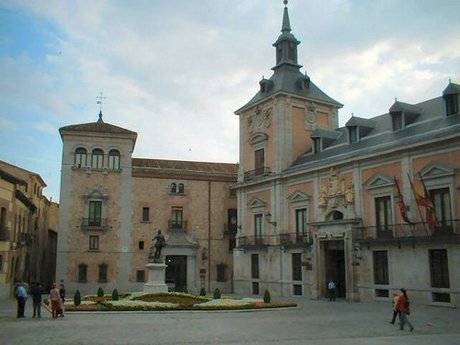Casa de la Villa
In the heart of “Madrid de los Austrias” (Madrid of the Hapsburgs), there is a pretty and charming square called Plaza de la Villa which is home to a statue in honor of Álvaro de Bazán (19th Century). Alongside the square is Casa de la Villa House, designed by Juan Gómez de Mora in the 17th Century and formerly used as a prison. The large exterior balcony and doorways are outstanding. Next to it stands Casa de Cisneros House, a 16th century palace rebuilt at the beginning of the 20th century. Inside, the Tapestry Room is a highlight, with an impressive collection of extraordinary quality.
The Plaza de la Villa (Town Square) is a picturesque small square in the heart of Madrid, not far from the much larger Plaza Mayor. In contrary to the latter, the buildings at the Plaza de la Villa all have contrasting styles. The largest building at the square is the former Town Hall or Casa de la Villa (ayuntamiento). Construction started in 1644 by Juan Gómez de Mora, the architect of the Plaza Mayor. Over time a number of architects were in charge of the construction of the Town Hall until it was finished in 1696 by Teodoro Adremans. The building served both as town hall and prison, hence the two symmetrical doors. The left one gave entrance to the prison, the other one to the town hall.
In 2007 the grander 'Palacio de Comunicaciones' took over the role of Madrid's town hall.
The Casa de la Villa is the old Town Hall of Madrid, situated in the charming historic Plaza de la Villa, between Plaza del Sol and Plaza de Oriente. The Plaza was one of the focal points of activity in mediaeval Madrid when it was first known as the Plaza de San Salvador, because of a nearby church bearing that name.
The Casa de la Villa originally served the City of Madrid as both prison and Town Hall, and the two entrances go back to the time when it had this dual function. In 2007 the seat of the City's administration was moved to the Palacio de Comunicaciones near Cibeles, but the Casa de la Villa is still used on occasion.
Work began on the Casa de la Villa in 1645 when the architect Juan Gomez de Mora was charged with creating a suitable headquarters for council meetings. Prior to this, before the capital of Spain was moved to Madrid from Toledo, Madrid had no specific place to hold its council meetings, and they were held in the church of San Salvador in the Calle Mayor or in the houses of the Council members themselves.
Work on the building was not completed until 1696 when Teodoro Ardemans added the final sections, although the columns facing onto the Calle Mayor were added much later, in 1789. The building is made of granite, and above the main entrance is the Coat of Arms of the City of Madrid.
Inside, the ceiling of the Salon de Plenos is decorated with late 17th century frescoes by Antonio Palomino, and the impressive Patio de Cristal, or Glass Patio, is covered by a stained glass roof depicting the city's coat of arms and the Puerta de Alcalá.
The Goya Room is named after Goya's "La Alegoria de Madrid", in which the city is represented as a woman sitting next to the city's coat of arms. The final room on the tour is the Sala de la Carreta, whose walls are adorned with portraits of the various Mayors of Madrid.
Free guided tours of the building take place on Mondays at 5pm, and are available in both Spanish and English. Other buildings of interest in the square are the 15th century Gothic Lujanes House and Tower, and the 16th century Cisnero Palace. The square adjoins the Calle Mayor, and the nearest metro station is Opera, but Sol is also within walking distance. You can get there via flight to Madrid.



